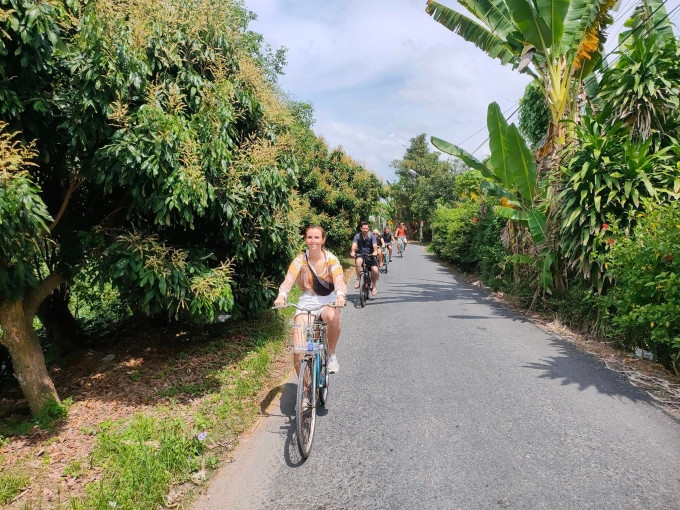According to experts, Vietnam's tourism industry should set an ambitious goal of welcoming international visitors like Thailand or recovering to pre-pandemic levels.
Data from the National Tourism Administration released on November 29 showed that in the first 11 months of the year, Vietnam welcomed more than 11.2 million international visitors, nearly 1.5 times higher than the target set at the beginning of the year of 8 million. However, this figure is only 62% compared to the same period in 2019.
Associate Professor Dr. Pham Hong Long, Head of the Department of Tourism Studies, Hanoi University of Social Sciences and Humanities, said that based on the above data, Vietnam could welcome 13-13.5 million visitors by the end of 2023. In 2024, the number could reach 14-15 million if no unexpected problems arise.
Director of the Asian Tourism Development Institute Pham Hai Quynh also said that the target of 15 million international visitors "is a feasible number and suitable for Vietnam's tourism development in 2024".

International visitors join the cycling experience, exploring the Vietnamese countryside
Lux Group CEO Pham Ha posed a higher challenge when he said that "Vietnam needs to be as ambitious as Thailand". Instead of setting a target of welcoming visitors in 2019, Vietnam can set a more ambitious target of 20 million. "Let's boldly set a target of welcoming half of Thailand's peak and from there be determined to turn the goal into reality", Mr. Ha said.
In a previous interview, General Secretary of the Vietnam Tourism Association (VITA) Vu Quoc Tri also expressed his wish that the entire industry set a goal of "fully recovering tourism by 2024". "We will try to achieve all targets next year like 2019, the peak year of Vietnamese tourism", Mr. Tri said.
In 2019, Vietnam welcomed 18 million international visitors, an increase of 16.2% compared to 2018, with total tourism revenue reaching 32.5 billion USD (an increase of 18.5%). 2019 was also the year when Vietnam's international visitor growth was higher than the global average (3.8%) and the Asia-Pacific region (4.6%), according to data from the World Tourism Organization (UNWTO).
According to Mr. Tri, Vietnam's tourism industry needs to speed up its recovery. If it takes 3 years to return to pre-pandemic levels, it will be "too slow" and other countries may overtake it. "We have not fully recovered, so how can we talk about speeding up?", Mr. Tri said.
Thailand has set clear targets for 2024 and plans to achieve them. Prommin Lertsuridej, a top aide to Thai Prime Minister Srettha Thavisin, said on November 19 that the government plans to further relax visa policies for some European countries and grant permits for more than 3,000 events to attract tourists to visit next year. The Tourism Authority of Thailand (TAT) aims to raise tourism revenue from international visitors back to pre-pandemic levels of at least $57 billion by 2024.
"Vietnam is still cautious in setting goals," said Mr. Tri.
To achieve the goal of recovering to pre-pandemic levels or higher in 2024, Mr. Pham Ha said it is necessary to position the tourism brand more clearly for the international tourist market. In addition to measures such as tourism promotion, Vietnam needs to "speak the language of each tourist market". "It is necessary to understand the needs of each tourist market and serve what they need. Asian tourists will certainly have different needs than European tourists," Mr. Ha added.
In addition to focusing on traditional tourist markets such as China, Vietnam needs to target new markets with more room for growth, such as Northern Europe. Northern European visitors often take long vacations, up to 30 days, and therefore spend more. Rich visitors from India, the Middle East, Australia, and New Zealand are also a suggestion. In addition to simplifying visa procedures, Vietnam needs to open more direct flights to these countries and provide tourism products that they love so that visitors not only come more but also increase the return rate. According to a 2018 survey by the Pacific Asia Travel Association, the rate of visitors returning to Vietnam is about 10-40%, while Thailand is 80%.

Tourists visit Hang Mua, Ninh Binh
Associate Professor Dr. Pham Hong Long added that in addition to quantity, the tourism industry also needs to pay attention to the quality of visitors and increase their spending capacity. To attract more visitors and to spend more, it is necessary to improve the image of Vietnam tourism by managing destinations well, creating a green and clean environment, and enhancing the competitiveness of destinations. In addition to tourism support policies, Vietnam also needs good connections between supply chains. Travel companies will find it difficult to sell tours if hotel room prices, airfares, and meals for guests all increase. According to Mr. Long, the supply chain in Vietnam is still loose and weak.
Vietnam needs to open more tourism promotion centers in key markets like the model TAT Thailand is doing. Currently, TAT has more than 20 representative offices around the world. In each country, TAT has its own promotional campaign to attract tourists.
Mr. Pham Hai Quynh believes that becoming a safe and reliable destination with quality tourism services is also a way for Vietnam to attract more tourists after the pandemic. It is necessary to retrain and manage human resources in the tourism industry to serve customers more professionally as well as invest in developing transport infrastructure, clean water, and electricity to help customers feel convenient and comfortable when coming.
However, according to Mr. Tri, it is impossible to put all the work on the tourism industry. Welcoming 18 million international visitors by 2024 is "the desire of those working in tourism" but it is also necessary to consider unexpected factors such as natural disasters and epidemics to be able to complete the set goal or not. Vietnam needs the coordination of other agencies and departments. Thailand's tourism is developing as it is today because "the whole country is doing tourism", from aviation, transportation to infrastructure, electricity, water, energy, agricultural production, and heavy industries.
VITA's General Secretary believes that we should not be "too pessimistic about Vietnam's tourism" because "the tourism industry is doing well and making progress". This is not only reflected in the number of visitors growing each year and ranking in the top 4 in Southeast Asia in 2019, but also in the contribution of tourism to GDP. "In 2015, the tourism industry contributed more than 6% to GDP. In 2019, that figure was more than 9%", said Mr. Tri.
According to VnExpress